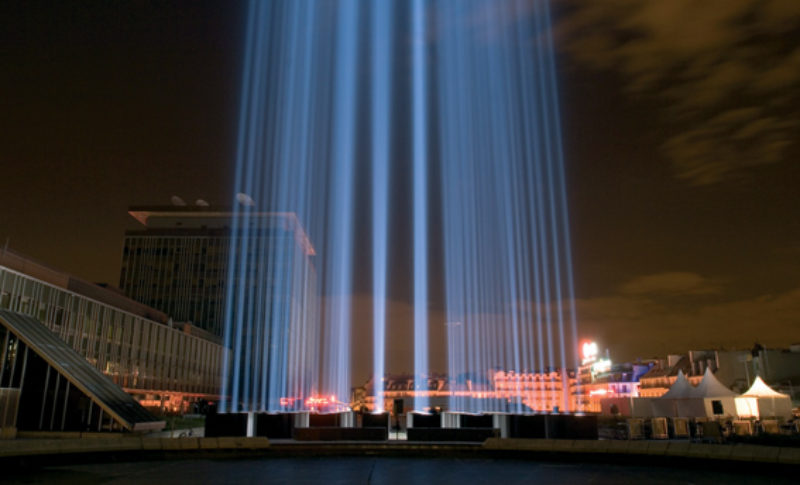Ryoji Ikeda, Nuit Blanche 4/5 October, Tour Montparnasse
11 October 2008–12 January 2009 Le Laboratoire, Paris

It may be coincidence that Ryoji Ikeda’s commission for Nuit Blanche adhered to the late night festival’s title with such literal exactitude. But, the artist and musician’s contribution to this year’s all night affair demanded a curious inquisition that marks it as the most public and diversely interpreted work in the city-wide event.
Ikeda’s ‘spectra [paris]’, 2008, a grid of lights beamed kilometres upwards into the night sky and was visible from all over the city, dwarfing the neighbouring Tour Montparnasse (Paris’ tallest building). A development of a previous work, ‘spectra [amsterdam]’, 2008, 64 columns of white light became a beacon for the immersive audio experience at their base, and from some angles could be seen to mask the adjacent contentious skyscraper. Understandably, Ikeda’s light and sound installation garnered a great deal of attention.
His arrangement was prime for this type of event; a large audience of curious bystanders, captivated by the spectacle were keen to investigate the noise and light intervention. Ultimately, as in a great number of temporal public works, the event defined itself, an experience, as opposed to being credited to the artist responsible. Which is more or less a positive response to a work of this nature: an anonymity provoked by its location and surreality, magnified by its ghostly appearance at 7pm and disappearance at 7am.
A beacon of reference as much as an artwork, it defined itself by comparison; a touchstone for those who identified the work as it was imposed on them: an artwork, a search light, the 9/11 memorial, or the not- so-distant memory of Jean Michel Jarre’s campy illumination of La Defence. For some, Ikeda’s work simply served as an orientational marker as they try to navigate the late night streets. Paris’ reputation as a ‘city of lights’ then worked to Ikeda’s advantage.
From its base the 64 floodlights beamed directly upward into the night sky, coming to a point (an optical trick) as they hit the cloud above the city. Viewing this work really was a collective experience, and unavoidable, as it drew so much attention due to its definition in the night sky. The soundwork, audible from streets away, its reverberations heard and felt in the metro stations below the streets, prime the viewer for the surreal encounter.
The sinister ‘soundtrack’ and network of columns that support the highpowered lights immersed the viewer in the disorientating environment. Ironically Ikeda’s spectra became a spectrum as rain passes through the beams of the installation, creating a deviation high up in the sky: an unexpected bonus for those fixated by the sight.
Ikeda’s one-night work announced the beginning of a series of events in the city, the second of which, a solo show of new work at Le Laboratoire (a new centre for art/ science collaborations) puts his work back into the realms of those willing to engage with its complex details.
However, the works in this exhibition have striking similarities to the Nuit Blanche presentation. Their minimal appearance masks complex multi-layered networks of thinking. The formal similarities to minimalism deceive the artist’s intentions but perhaps contain the ideas presented within in the fictitiousness of the artwork.
A comparative pair of prints are presented slab-like and lit like artefacts in the darkened gallery. Digital prints of thousands of tiny numbers that from a distance appear as solid grey planes, but on closer inspection reveal a sequence of numbers that ‘Barthianly’ require your trust in believing that one is the sum of a prime number, the other not.
True to Le Laboratoire’s commitment to art/science collaborations, these works were made together with mathematician Benedict Gross. Ikeda explores the beauty of the prime number, its significance and the visual representation in its complex relationship with his visual art and musical composition. A digital output in print as well as in their generation, Ikeda’s affiliation with digital media appear at odds with the mathematician and his pencil/paper solidarity.
Another notable work, ‘spectra III’, 2008, a corridor of perspex and fluorescent lights, emphasises the minimalist persuasion of Ikeda’s practice, as well as providing a contrast to the dark, museum-like interior of the first exhibition space. The bright short corridor provoking the philosophical space that detaches the viewer from the previous work and confronts them with a symmetrical visual perfection.
The clinical simplicity of this work purifies the environment within which Ikeda’s complex interests are exercised. His engagement provokes the phenomenological questions associated with mathematics and science, but ultimately relies on these truths becoming allegory in a space where they exist for their philosophical potentials: a space that is subjective, like the beauty of the prime number presented.
Steven Cairns is co-editor of MAP
